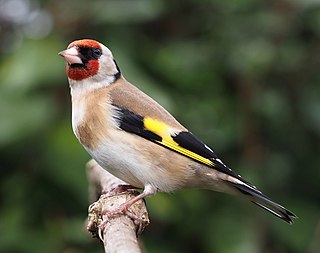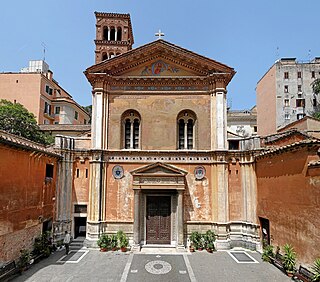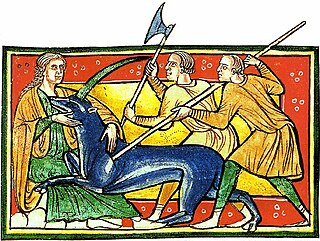
In Christian art, animal forms have at times occupied a place of importance. With the Renaissance, animals were nearly banished, except as an accessory to the human figure.

In Christian art, animal forms have at times occupied a place of importance. With the Renaissance, animals were nearly banished, except as an accessory to the human figure.
![Funerary stele inscribed IKhThU[?] ZONTON
("fish of the living"), early 3rd century Stele Licinia Amias Terme 67646.jpg](http://upload.wikimedia.org/wikipedia/commons/thumb/2/24/Stele_Licinia_Amias_Terme_67646.jpg/220px-Stele_Licinia_Amias_Terme_67646.jpg)
In the early days of Latin and Byzantine Christianity, many representations of animals are found in monumental sculpture, in illuminated manuscripts, in stained glass windows, and in tapestry. Reasons for this include: [a]
The paintings of the first period, as seen in the Catacombs of Rome, show us, usually, the lamb accompanying the Good Shepherd, a representation of the Christian soul during its earthly life. [a] The lamb was strongly associated with religious sacrifices in the ancient Near East, and was adopted as a symbol of Christ and his sacrifice on behalf of humanity. [1]
Birds, too, appear either as simple decorative elements transmitted from antique paintings, or used symbolically as in Noah's dove, symbolical of the Christian soul released by death; the peacock, with its ancient meaning of immortality, and the phoenix, the symbol of apotheosis. [a]
The symbol of perhaps the widest distribution is the Ichthys (Greek: ΙΧΘΥΣ, fish), used since the second century as an acronym for "Ίησοῦς Χριστός, Θεοῦ Υἱός, Σωτήρ" (Iesous Christos, Theou Huios, Soter), meaning "Jesus Christ, Son of God, Saviour". [2] Artistically, these various representations are somewhat crude, and show the decadence of the pagan art of the time. [a]
After the recognition of the Church by Constantine I in 313, the Book of Revelation is the source from which are derived most of the decorative themes of Christian Art. The lamb is now the most important of these, and its meaning is either the same as before or, more frequently perhaps, it is symbolic of Christ the expiatory victim. The dove is the Holy Spirit, and the four animals that St. John saw in Heaven [3] are used as personifications of the Four Evangelists. [a] [4] [5] Under the influence of Byzantine art, a great variety of fantastic animals, such as dragons, birds with human heads, winged lions, etc., entwined themselves around the decorative forms until foreign wars and the iconoclast movement brought this period of vigorous art to an end. [a]
During the succeeding three centuries, new types of animals appear only in Romanesque architecture. These are usually either purely fantastic or composite, that is, made up of elements of different species combined in one. Often, the subject grows out of foliage forms; and monsters are shown fighting and even devouring one another. [a]

In the spandrels of the entrance doorways, around the glorified Christ, the symbols of the four evangelists, namely the lion, the ox, the man, and the eagle are shown, holding the holy books. This is a favourite motif in the sculpture of the eleventh and twelfth centuries. Sometimes the jaws of a monster figure the entrance of Hell, into which sinners are plunged. [a]
Some of the most important symbolic animals are: [6]
| Animal | Attributes | Symbolism |
|---|---|---|
| Lamb | Innocence, purity, vulnerability | Christ [6] |
| Dog | Loyalty, watchfulness, trustworthiness | A person with those attributes [6] |
| Dove | Purity, peace | (If with halo) holy spirit [6] |
| Dragon | Powers of darkness | The devil [6] |
| Snake | cunning, deceit | The devil [6] |

With the beginning of the thirteenth century Gothic art affords the greatest number and the best representations of animal forms. The great cathedrals, especially those of the Isle of France, where sculpture reached its highest point of excellence, are a sort of encyclopedia of the knowledge of the time. They show, therefore, examples of all the then known animals, that is, whether by legend or experience. The bestiaries, developed in the twelfth century, are fully illustrated in the cathedrals in the stone carving of the capitals, the parapets, and the tops of the buttresses, and in the woodwork of the stalls. [a] [1]
There are birds of prey, wild boars, and feline forms on the towers of Notre Dame de Paris; birds covered with draperies, and elephants at Reims; enormous oxen on the towers of Laon placed there in memory of the service of those animals during the construction of the Cathedral. With the animals of the country, domestic or wild, those of remote parts of the earth, known by a few specimens, are also represented: the lion, the elephant, apes, etc.; legendary creatures also, like the unicorn, the basilisk (described by Pliny), the dragon, and the griffin. [a] [1] In classical times, the griffin was a keeper of light, attending Apollo, and Christians retained the griffin's association as a guardian of the dead. [1] Imaginary creatures are also frequent, and the gargoyles alone display a great variety. Viollet-le-Duc remarked that he did not know, in France, two gargoyles alike. [a] [7]
The symbolism which usually attaches to the various animals is derived for the most part from the bestiaries. Thus, for the lion, strength, vigilance, and courage; for the siren, voluptuousness; for the pelican, charity. The four animals which symbolize the leading characteristics of each of the Four Evangelists become more and more an accessory used to characterize the figure of the Evangelists themselves from the fifth century onwards. [a] [1]
In the same way many saints, when not characterized by the instruments of their martyrdom, are accompanied by animals which identify them; as, St. Roche, with a dog; St. Hubert, with a stag; St. Jerome, with a lion; St. Peter, with a cock; St. Paul the Hermit, with a raven; St. Gertrude of Nivelles, with a cat, etc. The Bible, also, gives some motives, as the ram of Isaac, the golden calf, the brazen serpent. [a]
With the fourteenth century, animals become less frequent in iconography. The fifteenth and sixteenth centuries use them again, but copied more closely from life, usually of small size, and often without any intention of symbolism. One finds now animals such as rats, snakes, rabbits, snails, and lizards. [a]

Raphael's Madonna del cardellino (Madonna of the Goldfinch) however portrays John the Baptist holding a goldfinch while Christ reaches out his arms to touch it. This is certainly symbolic; the bird is associated by legend with the crucifixion, the red spot on its head supposedly arising from a drop of Christ's blood. [8]

A bestiary is a compendium of beasts. Originating in the ancient world, bestiaries were made popular in the Middle Ages in illustrated volumes that described various animals and even rocks. The natural history and illustration of each beast was usually accompanied by a moral lesson. This reflected the belief that the world itself was the Word of God and that every living thing had its own special meaning. For example, the pelican, which was believed to tear open its breast to bring its young to life with its own blood, was a living representation of Jesus. Thus the bestiary is also a reference to the symbolic language of animals in Western Christian art and literature.

In architecture, and specifically Gothic architecture, a gargoyle is a carved or formed grotesque with a spout designed to convey water from a roof and away from the side of a building, thereby preventing it from running down masonry walls and eroding the mortar between. Architects often used multiple gargoyles on a building to divide the flow of rainwater off the roof to minimize potential damage from rainstorms. A trough is cut in the back of the gargoyle and rainwater typically exits through the open mouth. Gargoyles are usually elongated fantastical animals because their length determines how far water is directed from the wall. When Gothic flying buttresses were used, aqueducts were sometimes cut into the buttress to divert water over the aisle walls.

The European goldfinch or simply the goldfinch is a small passerine bird in the finch family that is native to Europe, North Africa and western and central Asia. It has been introduced to other areas, including Australia, New Zealand and Uruguay.

Early Christian art and architecture or Paleochristian art is the art produced by Christians or under Christian patronage from the earliest period of Christianity to, depending on the definition used, sometime between 260 and 525. In practice, identifiably Christian art only survives from the 2nd century onwards. After 550 at the latest, Christian art is classified as Byzantine, or of some other regional type.

A tetramorph is a symbolic arrangement of four differing elements, or the combination of four disparate elements in one unit. The term is derived from the Greek tetra, meaning four, and morph, shape.

In Christian tradition, the Four Evangelists are Matthew, Mark, Luke, and John, the authors attributed with the creation of the four canonical Gospel accounts. In the New Testament, they bear the following titles: the Gospel of Matthew; the Gospel of Mark; the Gospel of Luke; and the Gospel of John. These names were assigned to the works by the early church fathers in the 2nd century AD; none of the writers signed their work.

Evangelist portraits are a specific type of miniature included in ancient and mediaeval illuminated manuscript Gospel Books, and later in Bibles and other books, as well as other media. Each Gospel of the Four Evangelists, the books of Matthew, Mark, Luke, and John, may be prefaced by a portrait of the Evangelist, usually occupying a full page. Their symbols may be shown with them, or separately. Often they are the only figurative illumination in the manuscript. They are a common feature in larger Gospel Books from the earliest examples in the 6th century until the decline of that format for illustrated books in the High Middle Ages, by which time their conventions were being used for portraits of other authors.

A crux gemmata is a form of cross typical of Early Christian and Early Medieval art, where the cross, or at least its front side, is principally decorated with jewels. In an actual cross, rather than a painted image of one, the reverse side often has engraved images of the Crucifixion of Jesus or other subjects.

The Basilica of Sant' Apollinare in Classe is a church in Classe, Ravenna, Italy, consecrated on 9 May 549 by the bishop Maximian and dedicated to Saint Apollinaris, the first bishop of Ravenna and Classe.

Santa Pudenziana is a church of Rome, a basilica built in the 4th century and dedicated to Saint Pudentiana, sister of Praxedes and daughter of Pudens. It is one of the national churches in Rome, associated with Filipinos.

Symbolism of Christian saints has been used from the very beginnings of the religion. Each saint is said to have led an exemplary life and symbols have been used to tell these stories throughout the history of the Church. A number of Christian saints are traditionally represented by a symbol or iconic motif associated with their life, termed an attribute or emblem, in order to identify them. The study of these forms part of iconography in art history. They were particularly used so that the illiterate could recognize a scene, and to give each of the Saints something of a personality in art. They are often carried in the hand by the Saint.

The term Poor Man's Bible has come into use in modern times to describe works of art within churches and cathedrals which either individually or collectively have been created to illustrate the teachings of the Bible for a largely illiterate population. These artworks may take the form of carvings, paintings, mosaics or stained-glass windows. In some churches a single artwork, such as a stained-glass window, has the role of Poor Man's Bible, while in others, the entire church is decorated with a complex biblical narrative that unites in a single scheme.

Christian symbolism is the use of symbols, including archetypes, acts, artwork or events, by Christianity. It invests objects or actions with an inner meaning expressing Christian ideas.
Rev. Félix Granda y Álvarez Buylla was a Spanish Roman Catholic priest and sacred artist who founded the liturgical art workshop Talleres de Arte and directed its activities until his death. The workshop is now known as Talleres de Arte Granda in Spanish-speaking countries and as Granda Liturgical Arts in English-speaking countries.

Hybrid beasts are creatures composed of parts from different animals, including humans, appearing in the folklore of a variety of cultures as legendary creatures.

A legendary creature is a type of fantasy entity, typically a hybrid, that has not been proven and that is described in folklore, but may be featured in historical accounts before modernity.

Rabbits and hares (Leporidae) are common motifs in the visual arts, with variable mythological and artistic meanings in different cultures. The rabbit as well as the hare have been associated with moon deities and may signify rebirth or resurrection. They may also be symbols of fertility or sensuality, and they appear in depictions of hunting and spring scenes in the Labours of the Months.

The Worksop Bestiary, also known as the Morgan Bestiary, most likely from Lincoln or York, England, is an illuminated manuscript created around 1185, containing a bestiary and other compiled medieval Latin texts on natural history. The manuscript has influenced many other bestiaries throughout the medieval world and is possibly part of the same group as the Aberdeen Bestiary, Alnwick Bestiary, St.Petersburg Bestiary, and other similar Bestiaries. Now residing in the Morgan Library & Museum in New York, the manuscript has had a long history of church, royal, government, and scholarly ownership.

The Vyšší Brod (Hohenfurth) cycle, ranks among the most important monuments of European Gothic painting. It is made up of nine panel paintings depicting scenes from the Life of Christ, covering his childhood, Passion and resurrection. These paintings were made between 1345 and 1350 in the workshop of the Master of Vyšší Brod that was most probably based in Prague. The pictures were either meant for a square altar retable or else they decorated the choir partition of the church of the Cistercian Abbey in Vyšší Brod.

The lion is one of the most depicted felines in art. It appears as early as the Palaeolithic on cave paintings. Depicted on the thrones of monarchs or guarding temples, the image of the lion was closely linked to royalty and protection in Antiquity. A therianthropic creature in ancient Egypt, it was most often depicted realistically in Mesopotamian and Greco-Roman civilizations.
English trans. of 3rd edn
{{cite book}}: CS1 maint: location missing publisher (link)